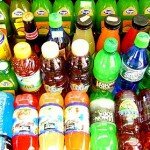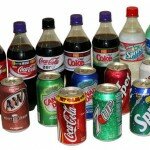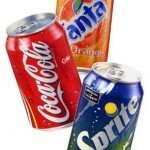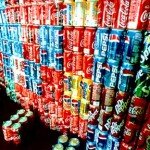Soft drinks
April 21, 2007 – 9:11 pm
Soft drinks
Carbonated drinks were called as soft drinks initially (though being popular as soda in U.S. and as pop in U.K.) but now the term soft drink applies to all cold drinks not containing alcohol. Beverages like cola, lemonade, sparkling water, and fruit punch are classified as soft drinks while tea, coffee, hot chocolate, milk, milk shakes are not classified as soft drinks.
The carbonated beverages are produced by dissolving carbon dioxide into the liquid at a very high pressure. At high pressure the solubility of carbon dioxide is more than at normal pressure, hence high pressure is used. When the bottle/can of the beverage is opened, the carbon dioxide comes out in the form of bubbles and after the whole carbon dioxide is released the drink is said to be flat. Carbonated drinks taste sharper due to the presence of carbonic acid in them which gives a slight burning sensation. Another method for carbonation is to do partial fermentation in a sealed container. This particular method is used to make the very popular ginger beer. By using appropriate yeasts and appropriate process control the alcohol level in the beverage can be made negligible.
A “float†is made when a scoop of ice cream is added to a soft drink. In some parts of United States, instead of calling ice cream in soda a float, it is called an “ice cream soda†or “soda†as they are made at soda fountains. The same beverage is known as “Spider†in Australia and New Zealand, “ice-cream soda†in Scotland. Root beer float is the most common type of float. In Brazil, the floats are named according to the color of the float e.g. ice cream in cola is called “vaca preta†which means black cow and strawberry ice cream in lemon soft drink is called “pantera cor de rosa†which means “the pink pantherâ€.



There has been a lot of controversy whether soft drinks are a health hazard or not. Many soft drinks contain sugar more than what is specified in recommended daily allotment (RDA) of USDA along with having no nutritional value in terms of minerals, vitamins, proteins, fibers or any other essential nutrients. Soft drinks generally contain additives such as artificial food colors, flavors, preservatives and emulsifiers which are not approved by all consumers. The consumption of soft drinks is also worrying people as children tend to give preference to soft drinks rather than to healthier drinks as milk and fruit juice.
Soft drinks are also held responsible for increasing obesity in children in recent years. It was shown by Dr. David Ludwig of Boston Children’s Hospital that children who drink more than 8 fl. ounces (240 ml) of sweetened drinks regularly consume 835 calories more than children who avoided soft drinks. It implied that children consuming soft drinks on a regular basis used to eat a lot more than food that those not consuming it. This could be attributed to their lack of restraint or rise in insulin which makes them more hungry. Also soft drinks are generally consumed with fast foods such as chips, burgers, pizzas, French fries. Pediatrics published a paper in March 2006, Effect of Decreasing sugar-Sweetened Beverage Consumption on Body Weight in Adolescents: A Randomized, Controlled pilot Study.†The paper suggested that body mass index (BMI) can be reduced by reducing the intake of soft drinks in teenagers.Â
Most of the soft drinks available in market are acidic, having a pH of 3.0 or lower. Due to the acidic nature of the soft drink they can cause damage to the enamel of the teeth. Drinking through a straw may be advised as in this case the drink does not come into contact with the teeth. Brushing your teeth right after having soft drinks should be avoided as this may cause further erosion of enamel.
In response to rising health concern among American citizens, the Alliance for a Healthier Generation, Coca-Cola, PepsiCo, Cadbury Schweppes and the American Beverage Association announced “School Beverage Guidelines†on 3rd May 2006 which proposed voluntary removal of high-calorie soft drinks from US schools. UK Education Secretary, Alan Johnson, banned the sale of junk food and soft drinks in schools from September 2006. In August 2006, there was a report which indicated presence of pesticides in soft drinks being sold in India. Several states of India banned the sale of soft drinks. The companies manufacturing soft drink issued public notices denying this and asking consumers to have faith in them and their product.
Carcinogens are cancer causing agents or substances. Benzene, a carcinogen, was a contaminant found in the soft drinks as early as 1990. Initially contaminated carbon dioxide was supposed to be the source of benzene contamination but it was shown that acids and benzoates reacted to produce benzene. Out of 150 products tested for presence of benzene in 2006 in UK by Food Standards Agency, four were found having benzene levels above the World Health Organization (WHO) guidelines. In an unprecedented move these products were asked to be removed from sale. The United States Food and Drug Administration (FDA) also tested soft drinks for presence of benzene and the results were not encouraging. The Environmental Protection Agency recommends a standard of 5ppb for benzene level. Five of the beverages tested had benzene levels above this limit.
Soft drinks are sold in two-liter bottles, one liter plastic bottle, 24 and 20 fluid ounce bottle and 12 fluid ounce cans in US. In Japan they are sold as 1.5 liter, 500 ml and 350 ml bottles. In Europe plastic and glass bottles of 2, 1.5, 1, 0.5, 0.35, 0.33 are available.

3 Responses to “Soft drinks”
JEW GOLD!!!!!!!!!!
By Kyle Broffloski! on Apr 15, 2010
Congratulation for gave us the genesis o f soft drinks.try to help me because now I done research paper concerning on CONTRIBUTION OF SOFT DRINKS INDUSTRY ON POVERTY ALLEVIATION IN MWANZA TANZANIA at the place o Nyakato ward.it is funny to me to do this research paper
By JOSEPH MASAJE on Jan 10, 2011
My name is Alhagie sillah I am interested your product kindly send me quote.
By Alhagie Sillah on Dec 23, 2011